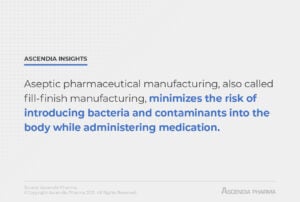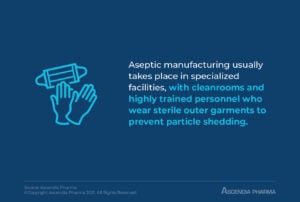Aseptic Pharmaceutical Manufacturing: How It Works
Although the pharmaceutical manufacturing process places a high value on cleanliness and minimizing the risk of contamination, it’s even more important when it comes to injectable drugs and those that come into contact with mucus membranes. Parenteral drugs bypass the body’s usual defenses against pathogens, so it’s critical that they are manufactured in sterile conditions.
What Is Aseptic Pharmaceutical Manufacturing?

Aseptic pharmaceutical manufacturing is most commonly used for most vaccines, biologics, other injectable drugs, cancer drugs, ear drops, nasal spray, and eye drops. Also known as fill-finish manufacturing, aseptic manufacturing minimizes the risk of introducing bacteria and contaminants into the body while administering medication.
Aseptic processing of pharmaceuticals involves virtually every step of the manufacturing process, from the formulation to the filling, then inspection, labeling, and packaging. Skilled manufacturing partners are needed for aseptic manufacturing, as errors can cause production delays, health risks, and the loss of product.
Current Good Manufacturing Process (cGMP) standards from the FDA stipulate that aseptic pharmaceutical manufacturers must:
- • Have a separate, classified clean area
- • Ensure that air is filtered and properly circulated
- • Sterilize and maintain all containers and closures
- • Have personnel that are dressed in sterile clothes, properly trained, and closely monitored
- • Set time limits for different steps of the manufacturing process
- • Simulate and record the manufacturing process
The Aseptic Manufacturing Process

Because aseptic manufacturing practices are applied to the entire drug manufacturing process, aseptic manufacturing usually takes place in specialized facilities, with cleanrooms and highly trained personnel who wear sterile outer garments to prevent particle shedding. These facilities are under regulatory scrutiny because of the complexity of the process and the risk to consumers should these drugs carry live pathogens. The aseptic manufacturing process includes the following steps
Bulk Drug Substance Arrival
The bulk drug substance, or BDS, is delivered to the manufacturing facility and transferred to storage until it is needed. If the BDS is for the manufacture of a biologic, its quality is ensured through end-to-end cold-chain infrastructure and traceability. When it’s anticipated that a BDS will need to be stored for an extended time, transfer and storage procedures must be carefully managed to keep the BDS sterile and at the ideal temperature.
In aseptic drug manufacturing, storage areas have to be monitored at all times, and there needs to be backup refrigeration systems and access to emergency power sources.
Pooling and Formulation
To keep the BDS from being exposed to outside air and potentially contaminated by airborne pathogens, thawing steps occur in closed systems. The BDS is pooled and formulated using a compounding and formulation suite in small or large tanks. In a typical manufacturing facility, there may be up to six rooms dedicated to this part of the process only.

Component Preparation
The equipment used for aseptic pharmaceutical manufacturing must also be sterile and free of contaminants. This includes the tools used in the filling line and isolator, as well as vial, syringe, and stopper or crimp cap preparations. Sterilization may be achieved by:
- Steam
This method uses an autoclave to sterilize equipment via steam. Steam sterilization is one of the most commonly used techniques because it’s effective for most pathogens, and autoclaves are often used for fill-finish equipment and connections between equipment. One potential downside of autoclaving is that it can begin to degrade tools and equipment from repeated exposure to heat and moisture.
- Dry Heat
A depyrogenation tunnel is used for dry heat sterilization, which destroys pyrogens (pathogens that cause fevers) by applying high heat for a specific amount of time. Dry heat sterilization is typically used to sterilize equipment in a continuous feed to the fill line.
- Fumigation
Fumigation is particularly well-suited for sterilizing large areas or pieces of equipment, or for equipment that can’t be accessed easily. Vapor phase hydrogen peroxide, chlorine dioxide, or ionized hydrogen peroxide gases are released into the air and, upon contact, kill any pathogens. The disadvantage of fumigation is that these gases are toxic to humans, and they can be corrosive on equipment.
- Gamma Radiation
Radiation is only used alongside other sterilization techniques in the aseptic manufacturing process. It’s most frequently used to sterilize products that are manufactured and then placed in packaging to keep the product sterile during shipment and handling. Single-use items are often sterilized with gamma radiation.
- E-Beam
This more modern approach to sterilization inactivates pathogens by destroying a key molecule or through an indirect chemical reaction. E-beams can penetrate boxes and shipping containers, so they are often used for sterilizing medical devices and pharmaceuticals that have already been packaged. They can also be used for surface decontamination.
Sterile Filtration
Microorganisms are removed from a drug prior to filling with sterile filtration. This filtration allows drug molecules to pass through while catching and filtering out microorganisms. For biologics, filtration commonly involves peristaltic pumps that allow for the adjustment of flow speed, minimizing the risk of loss from splashing or foaming. The sterile filtration process can be complex, and it may include multiple stages of filtration. For example, prefiltration is often used to remove contaminants as a first step in the filtration process; by removing larger particles, the lifespan of the final filter is extended.
Sampling and Testing
Sampling and testing occur throughout the aseptic manufacturing process, but one of the most crucial points is after sterile filtration. If contamination is found at this point, the entire batch of a drug will be discarded.
Aseptic Filling
In addition to managing the risk of contamination, aseptic drug manufacturing facilities must also prevent overfilling and underfilling during the filling process, as each of these leads to wasted money. Aseptic filling may involve pressure fills, diaphragm pumps, or peristaltic pumps. The drug containers, which include vials, syringes, cartridges, ampoules, and bottles, are also sterilized prior to filling; the type of sterilization used depends on whether the containers are plastic or glass.

Lyophilization
Sensitive drugs—particularly biologics—may be subject to lyophilization after filling. Essentially, the drugs are freeze-dried to stabilize the formulation. Once freeze-dried, the medication becomes a powder, which is easier to ship and store, and has a longer shelf-life. Sterile procedures must be followed when placing products in the freeze dryer and when removing them, as the lyophilization process presents many additional contamination risks.
Inspection
Whether the inspection process is handled by humans or semi or fully automated, it too must be sterile. Both products and containers are inspected to identify containers that have been under-filled, cosmetic and product defects, and other potential issues.
Shipping
The final step in the process for an aseptic drug manufacturer is shipment. To keep drugs secure and sterile all the way through shipment, the packaging is carefully designed to accommodate each type of drug, whether it’s a vial, bottle, IV bag, ampoule, injectable, or drops.
The aseptic manufacturing process is becoming increasingly automated, as robots dramatically reduce the risk of contamination by minimizing the amount of personnel needed. This is an exciting development to be sure, but with so many steps in the process of manufacturing aseptic drugs, we’re still a long way from full automation. Even once robots are more widely implemented, skilled personnel will still be needed to resolve unexpected errors, troubleshoot, and oversee operations.
What Is Sterile Manufacturing?

Sterile manufacturing and aseptic manufacturing are sometimes used interchangeably, but there’s an important difference between the two. Aseptic pharmaceutical manufacturing is carefully managed to ensure that there is no microbial contamination introduced at any point in the process. In contrast, sterile manufacturing focuses only on ensuring that the final product has no living microorganisms. This is why sterile manufacturing is also referred to as terminal sterilization.
Drugs that are manufactured with terminal sterilization include IV bag solutions like saline and dextrose, diluent solutions, and small molecule drugs that can withstand heat sterilization. FDA aseptic processing guidance states that terminal sterilization should be used for any drug that can go through the heat sterilization process without being compromised, and everything else must use aseptic processing.
Sterile manufacturing is much easier and less costly than aseptic manufacturing, which requires close management of every step of the process. There’s also less risk involved, not only because the end-product is sterilized, but also because the drugs that undergo the sterile manufacturing process aren’t injected; there’s more at stake should an error occur.
Sterile and Aseptic Manufacturing at Ascendia Pharma
At Ascendia, one of our specializations is manufacturing parenteral dosage forms, including cGMP clinical batches for early-stage clinical studies. We follow FDA processing guidance for the safety of Phase I investigational drugs, manufacturing sterile, injectable clinical trial dosages in our Class 100 (ISO 5) cleanroom. We can use isolator systems to limit the personnel needed and separate the external cleanroom from the aseptic processing line. Terminal sterilization using an autoclave is also available.
As biologics become more commonplace, the need for experienced aseptic manufacturers is growing. We understand the stringent standards required for aseptic manufacturing, and we’re committed to providing rapid, cost-effective development and manufacturing without ever compromising on patient safety.
Learn More About Aseptic Pharmaceutical Manufacturing
Contact us today to discuss your aseptic pharmaceutical manufacturing needs.

